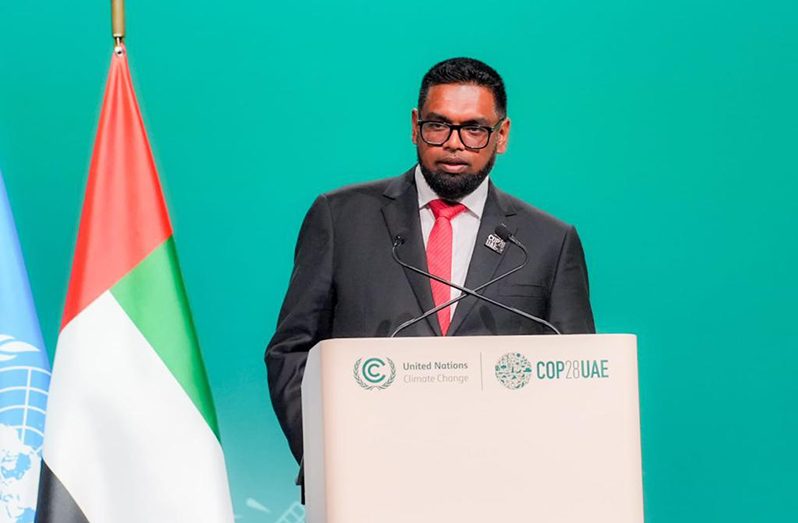–Guyana pledges commitment to achieve climate, energy security targets
BOASTING over 87 per cent of forest cover, Guyana has pledged to be a part of the “practical solution” to mitigating the effects of climate change.
At this year’s Conference of Parties to the UN Framework Convention on Climate Change (COP28) in Dubai, Guyana’s President Dr. Irfaan Ali said Guyana will be among the stewards of climate change, championing realistic solutions to the concerning phenomenon.
For decades, the country has sought out support to preserve its forest, while urging others to do likewise, and now as the effects of climate change have become intensely worrying, the South American nation provides a blueprint for action.
“We will always put practical solutions before abstract theories, so that we can play our part in finally bringing climate stability within reach,” President Ali told world leaders in Dubai.
HOW DID GUYANA GET SO FAMOUS FOR ITS FOREST?
Guyana’s annual deforestation rate averages at about 0.06 per cent, a rate which is 90 per cent lower than other tropical countries, and last year, it was 0.036 per cent. But how did Guyana get here?
Back in in 2009, the country had launched the first Low-carbon Development Strategy (LCDS) from a developing country, setting out a vision for inclusive, sustainable development, while simultaneously maintaining the country’s forests.
This saw the country signing its first deal where it was able to earn some US$250 million to keep its forest intact.
This further paved the way for the country to tap into the carbon-credit market, thereby allowing it to earn money for the carbon dioxide trapped by its standing forest.
In December 2022, the Architecture for REDD+ Transactions (ART) issued the world’s first TREES credits to Guyana. This marked a milestone, as it was the first time a country was issued carbon credits specifically designed for the voluntary and compliance carbon markets for successfully preventing forest loss and degradation, a process known as jurisdictional REDD+.
Following the completion of an independent validation and verification process and approval by the ART Board of Directors, ART issued 33.47 million TREES credits to Guyana for the five-year period from 2016 to 2020. This paved the way for a historic agreement between Hess Corporation and the Government of Guyana, whereby the oil giants opted to purchase about one-third of all Guyana’s credit (issued and anticipated) up to 2030.
The country’s forest stores 19.6 gigatonnes of carbon dioxide.
The agreement will see the country earning a minimum of US$750 million over the coming decade.
GUYANA AT COP
At this year’s global climate talks, the country has been tasked by the Commonwealth to provide leadership on its climate and forestry conservation strategy; the country is also co-chairing the carbon markets working group of the Forest and Climate Leaders Partnership (FCLP), consisting of 30 countries
“Along with our partners in the FCLP, we will be working to build high quality carbon markets so that forest communities and countries can prosper while keeping nature intact.
“We maintain one of the world’s most intact tropical forests, have one of the world’s lowest deforestation rates and store more than 19.5 Gigatons of carbon dioxide equivalents in that forest,” President Ali said.
Simultaneously, Guyana is balancing both its forest and the extraction of oil and gas resources.
“We are a carbon net-positive country, and aim to stay there… Our economy will grow more than three-fold while keeping energy-related emissions flat,” President Ali said.
He related that the country is building an ecosystem services economy, with forest carbon markets generating 4.5 per cent of government income this year alone.




.jpg)










